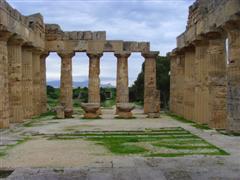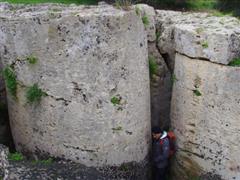Sunday, 13th December 2009
Posted by Judith on 15 Dec 2009 at 10:57 pm | Tagged as: Holiday
 We woke up in our plush hotel room and went to have our so-much-food-you-were-spoilt-for-choice breakfast, which was served on the top floor in a room with 270° views. In the dark we had seen the harbour lights and walked down for a nice pizza, but in daylight, the place was a building site. Four star hotel in one star surroundings.
We woke up in our plush hotel room and went to have our so-much-food-you-were-spoilt-for-choice breakfast, which was served on the top floor in a room with 270° views. In the dark we had seen the harbour lights and walked down for a nice pizza, but in daylight, the place was a building site. Four star hotel in one star surroundings.
We set off for what we came for… the Greek ruins. We resisted the tourist train tour of the site and walked. The temple complex at Selinunte contains five temples, four of which were destroyed by earthquakes. The remaining one is stunning. Looking at the piles of temple rubble is fascinating, as you can see the inner workings of the building. After looking at the first three, we went to the acropolis, which contains another temple and the remains of the city. There are still troughs, grind stones, etc. there. It’s an impressive place and it overlooks the sea.
While there, we learned that the Cave di Cusa, the quarry where the columns came from still exists and can be visited. It’s 12km from the site, but we couldn’t miss this amazing place. The columns were cut, in-situ, from a whole block of stone. So the workers would have to cut a channel (only as wide as a man) all around the column and it was then cut off at the bottom and levered over, before being dragged all the way to the temple site by oxen and slaves. The quarry was abandoned something like 2300 years ago, but you can still see columns started and abandoned.
 We decided to try to see another place while there was daylight, so drove to Sciacca. As we arrived it started raining, so we had a snooze but the rain got harder and harder until after an hour we gave up and drove to our next B&B, in Agrigento.
We decided to try to see another place while there was daylight, so drove to Sciacca. As we arrived it started raining, so we had a snooze but the rain got harder and harder until after an hour we gave up and drove to our next B&B, in Agrigento.
The Rough Guide describes the town as follows: “It would be a mistake not to scout around the modern town of Agrigento. Modern only by comparison with the temples, it’s thoroughly medieval at its heart. After the mean streets of some Sicilian towns, the long main drag, Via Antea is something of a revelation.”
The B&B we were staying at was described as in the old, run down part of the city. We got to the address and it was run down, but not old. Horrible, crumbling apartment blocks surrounded us. We were an hour early, and no one was answering the door, so we tried to find a bar. We walked around for ages, getting more and more disillusioned with area, but not finding any bars. We looked at the Rough Guide again and spotted the section we had previously missed. “No one comes to Agrigento for the town, though its worn medieval streets and buildings soak up thousands of tourists every year.” Oh, dear. At 7pm, the time we said we would be arriving, we called the B&B owner and he appeared 10 minutes later apologising that the online booking company had given us the wrong address. He took us up an amazingly steep road into the heart of the old town. The last bit was inaccessible by car and we had to walk. The place we were staying was indeed medieval. Exposed stone windows and the highest ceilings I have seen in a normal house. What a relief! Via Antea was indeed a revelation. After the run down, near empty residential area, the main drag was packed with people promenading. Everyone was dressed to the nines in their Sunday best and Geoff and I felt decidedly shabby. We found a really nice eatery where we managed to get a 5 course menu with local dishes. Once we had finished our meal and were ready for some more promenading, the streets were completely deserted.
Leave a reply
You must be logged in to post a comment.